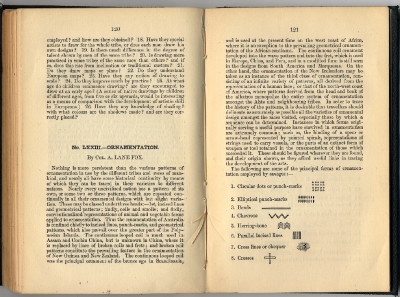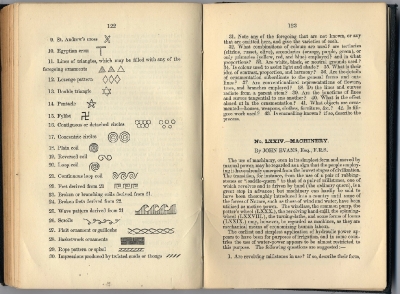To search the RPR site click here
Pitt-Rivers contributed sections for the first two editions of Notes and Queries (1874, 1892). In them both he drew up a section on drawing, in the second edition this was added to to include sculpture. In addition there was a section on ornamentation in both, they are transcribed here:
No LXXII DRAWING. [1874] or No. XXIII - Drawing and Sculpture [1892]
Great difference is observable in the capacity for drawing shown by different races. Thus the Esquimaux are comparatively skilful draughtsmen, whilst the Australians, as a rule, have but little knowledge of it. Amongst the relics found in the caves of Périgord, in France, life-like representations of animals have been discovered, whilst the rock-engravings of South America represent figures so grotesque as scarcely to be recognized. Care should, however, be taken to distinguish between the true representative art, however rude, which is the best attempt of natives to depict the objects truthfully, and conventionalized symbols, which are merely based upon the forms of nature. These, although of the utmost interest, come more properly under the head of writing or ornamentation, and must not be confounded with the former. The three branches, drawing, writing, and ornamentation, spring from a common centre; and the traveller should make it his best endeavour to classify the rock sculptures, carvings, and drawings of savages under one or other of these headings, assigning to each its true signification.
1. Have the natives a natural aptitude for drawing? 2. Do they draw animals in preference to other subjects? 3. Are the most conspicuous features, such as the head, nose, &c., generally exaggerated? 4. Have they the least knowledge of perspective? 5. Are the more distant objects drawn smaller than those nearer? 6. Are the more important personages or objects drawn larger than the others? 7. Do their drawings represent imaginary animals or animals now extinct? 8. Do they evince a tendency to introduce uniformity into the representation of irregular objects, such as trees, so as to produce a symmetrical pattern? 9. Are the drawings a. historical (XVIII/XLV.) b. religious (XXX/XXVII); c. obscene; d. symbolical or hieroglyphic (LXXI/ XXII); e ornamental (LXXIII/ XXIV); f badges or tribal marks, heraldic (LXIV/ LXIX) g copies from nature h imaginative designs; i topographical; k scribbles to occupy idle time, without any definite meaning? 10. Are events of different periods depicted in the same drawing? 11. Have they any conventional modes of representing certain objects? 12. Do they draw from nature, or copy each other's drawings? 13. Do they, in copying from one another, vary the designs through negligence, inability, or other causes, so as to lose sight of the original objects, and produce conventional forms the meaning of which is otherwise inexplicable? if so, it would be of great interest to obtain series of such drawings, showing the gradual departure from the original designs. 14. Do they readily understand European drawings? 15. Do they show any aptitude in copying European designs? 16. What are the materials usually employed for drawing? and with what tools are the carvings and engravings made? 17. What colours are employed, and how are they obtained? 18. Have they special artists to draw for the whole tribe, or does each man draw his own designs? 19. Is there much difference in the degree of talent shown by men of the same tribe? 20. Is drawing more practised in some tribes of the same race than others? and, if so, does this rise from inclination or traditional custom? 21. Do they draw maps or plans? 22. Do they understand European maps? 23. Have they any notion of drawing to scale? 24. Do they improve much by practise? 25. At what age do children commence drawing? are they encouraged to draw at an early age? (A series of native drawings by children of different ages, from five or six upwards, would be interesting as a means of comparison with the development of artistic skill in Europeans.) 26 Have they any knowledge of shading? with what colours are the shadows made? and are they correctly placed?
27. Do they carve bas-reliefs, or sculptures, in the round? 28. What materials are used for these sculptures--- stone, wood, &c.? 29. Do they represent natural objects, such as men and animals? 30. Are they naturalistic or purely conventional? or both? and if so, why is the distinction made? 31. Are the carved figures representations of gods or ancestors? (XXVII) of totems; (XL) signs of taboo (XXXVII)? 32. Are these figures kept in special houses or temples? or does each household have one or more of its own? 33. Are there any ancient carvings or statues of which the natives can give no account? C.H.R. [Charles Hercules Read]
No. LXXIII -- ORNAMENTATION. By Col. A. LANE FOX
Nothing is more persistent than the various patterns of ornamentation in use by the different tribes and races of mankind, and nearly all have some historical continuity by means of which they can be traced in their varieties to different nations. Nearly every uncivilized nation has a pattern of its own, or some two or three patterns, which are repeated continually in all their ornamental designs with but slight variation. They may be classed under three heads:- 1st, incised lines and geometrical patterns; 2ndly, coils and scrolls; and 3rdly, conventionalized representations of animal and vegetable forms applied to ornamentation. Thus the ornamentation of Australia is confined chiefly to incised lines, punch-marks, and geometrical patterns, which also prevail over the greater part of the Polynesian Islands. The continuous looped coil is much used in Assam and Cochin China, but is unknown in China, where it is replaced by lines of broken coils and frets; and broken coil patterns constitute the prevailing feature in the ornamentation of New Guinea and New Zealand. The continuous looped coil was the principal ornament of the bronze age in Scandinavia, and is used at the present time on the west coast of Africa, where it is an exception to the prevailing geometrical ornamentation of the African continent. The continuous coil ornament developed into the wave pattern and into the fret, which is used in Europe, China, and Peru, and in a modified form is still seen in the designs from South America and Marquesas. On the other hand, the ornamentation of the New Irelanders may be taken as an instance of the third class of ornamentation, consisting of an infinite variety of patterns, all derived from the representation of a human face; or that of the north-west coast of America, where patterns derived from the head and beak of the albatros monopolize the entire system of ornamentation amongst the Ahts and neighbouring tribes. In order to trace the history of the patterns, it is desirable that travellers should delineate as accurately as possible all the varieties of ornamental design amongst the races visited, especially those by which a sequence can be determined. Instances in which forms originally serving a useful purpose have survived in ornamentation are extremely common; such as, the binding of a spear or arrow-head represented by painted spirals, representations of string used to carry vessels, or the parts of an extinct form of weapon or tool retained in the ornamentation of those which succeeded it. These should be figured wherever they are found, and their origin show, as they afford useful links in tracing the development of the arts.
The following are some of the principal forms of ornamentation employed by savages. [see pages 120-121, 122-123 illustrations]
1. Circular dots or punch-marks.
2. Elliptical punch-marks
3. Bands
4. Chevrons
5. Herring-bone
6. Parallel incised lines
7. Cross-lines or chequer
8. Crosses
9. St Andrew's cross
10. Egyptian cross
11. Lines of triangles, which may be filled with any of the foregoing ornaments
12. Lozenge patterns
13. Double triangle
14. Pentacle
15. Fylfot
16. Contiguous or detached circles
17. Concentric circles
18. Plain coil
19. Reversed coil
20. Loop coil
21. Continuous loop coil
22. Fret derived from 21
23. Broken or branching coils derived from 21
24. Broken frets derived from 22
25. Wave pattern derived from 21
26. Scrolls
27. Plait ornament or guilloche
28. Basketwork ornaments
29. Rope pattern or spiral
30. Impression produced by twisted cords or thongs
31. Note any of the foregoing, that are not known, or any that are omitted here, and give the varieties of each
32. What combinations of colours are used? are tertiaries (citrine, russet, olive), secondaries (orange, purple, green), or only primaries (yellow, red, and blue) employed? and in what proportions? 33. Are white, black, or neutral grounds used? 34. Is colour used to assist light and shade? 35. What is their idea of contrast, proportions and harmony? 36. Are the details of ornamentation subordinate to the general forms and outlines? 37. Are conventionalized representations of flowers, trees, and branches employed? 38. Do the lines and curves radiate from a parent stem. 39. Are the junctions of lines and curves tangential to one another? 40. What is the effect aimed at in the ornamentation? 41. What objects are ornamented - houses, weapons, clothes, furniture &c.? 42. Is filigree work used? 43. Is enamelling known? if so, describe the process.
Transcribed AP November 2011





